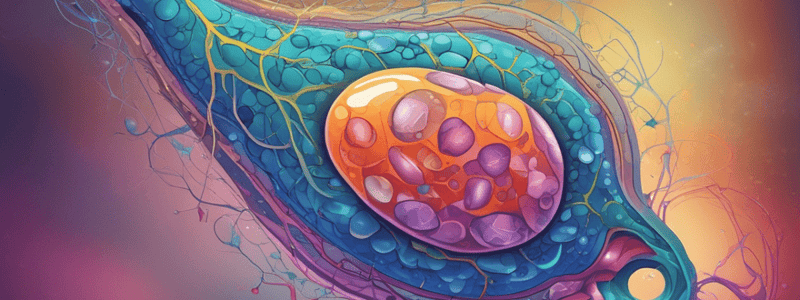Podcast
Questions and Answers
Every organism starts life as a single ______ which divides and redivides.
Every organism starts life as a single ______ which divides and redivides.
cell
Cells get differentiated (specialized) into different types and form ______.
Cells get differentiated (specialized) into different types and form ______.
tissues
[Blank] is defined as the smallest structural and functional unit of life.
[Blank] is defined as the smallest structural and functional unit of life.
A cell
The discovery of ______ was first observed by Robert Hooke in 1665.
The discovery of ______ was first observed by Robert Hooke in 1665.
Robert Brown discovered the ______ in 1831.
Robert Brown discovered the ______ in 1831.
Rudolf Virchow established that all cells arise from ______.
Rudolf Virchow established that all cells arise from ______.
He observed dead cells which resembled honeycomb like structures in ______.
He observed dead cells which resembled honeycomb like structures in ______.
He called these boxes as ______.
He called these boxes as ______.
He published what he observed under microscope in his book ______.
He published what he observed under microscope in his book ______.
Antony Van Leeuwenhoek was the first one to observe living cells in ______ water.
Antony Van Leeuwenhoek was the first one to observe living cells in ______ water.
J.E.Purkinje used the term ______ to describe the living matter present inside the cell.
J.E.Purkinje used the term ______ to describe the living matter present inside the cell.
Rudolf Virchow was a German ______.
Rudolf Virchow was a German ______.
What is the process by which cells become specialized for different functions?
What is the process by which cells become specialized for different functions?
What is the term used to describe the living matter present inside the cell?
What is the term used to describe the living matter present inside the cell?
What was observed by Robert Hooke in the cork under the microscope?
What was observed by Robert Hooke in the cork under the microscope?
Who was the first to observe living cells?
Who was the first to observe living cells?
What is the fundamental concept established by Rudolf Virchow?
What is the fundamental concept established by Rudolf Virchow?
In what type of water did Antony Van Leeuwenhoek observe living cells?
In what type of water did Antony Van Leeuwenhoek observe living cells?
Flashcards are hidden until you start studying
Study Notes
Cell-Structure and Function
- Every organism starts life as a single cell, which divides and redivides to form tissues and eventually, organs.
- Cells are the smallest structural and functional unit of life, visible only with a microscope.
Discovery of Cell
- Robert Hooke (1665) observed dead cells resembling honeycomb-like structures in cork, and termed them as "cells".
- Antony Van Leeuwenhoek (1674) was the first to observe living cells in pond water.
- Robert Brown (1831) discovered the nucleus.
- J.E.Purkinje (1839) coined the term "protoplasm" to describe the living matter present inside cells.
- Rudolf Virchow (1855) established that all cells arise from pre-existing cells, stating "omnis cellula e cellula".
Cell-Structure and Function
- Every organism starts life as a single cell, which divides and redivides to form tissues and eventually, organs.
- Cells are the smallest structural and functional unit of life, visible only with a microscope.
Discovery of Cell
- Robert Hooke (1665) observed dead cells resembling honeycomb-like structures in cork, and termed them as "cells".
- Antony Van Leeuwenhoek (1674) was the first to observe living cells in pond water.
- Robert Brown (1831) discovered the nucleus.
- J.E.Purkinje (1839) coined the term "protoplasm" to describe the living matter present inside cells.
- Rudolf Virchow (1855) established that all cells arise from pre-existing cells, stating "omnis cellula e cellula".
Cell-Structure and Function
- Every organism starts life as a single cell, which divides and redivides to form tissues and eventually, organs.
- Cells are the smallest structural and functional unit of life, visible only with a microscope.
Discovery of Cell
- Robert Hooke (1665) observed dead cells resembling honeycomb-like structures in cork, and termed them as "cells".
- Antony Van Leeuwenhoek (1674) was the first to observe living cells in pond water.
- Robert Brown (1831) discovered the nucleus.
- J.E.Purkinje (1839) coined the term "protoplasm" to describe the living matter present inside cells.
- Rudolf Virchow (1855) established that all cells arise from pre-existing cells, stating "omnis cellula e cellula".
Studying That Suits You
Use AI to generate personalized quizzes and flashcards to suit your learning preferences.




